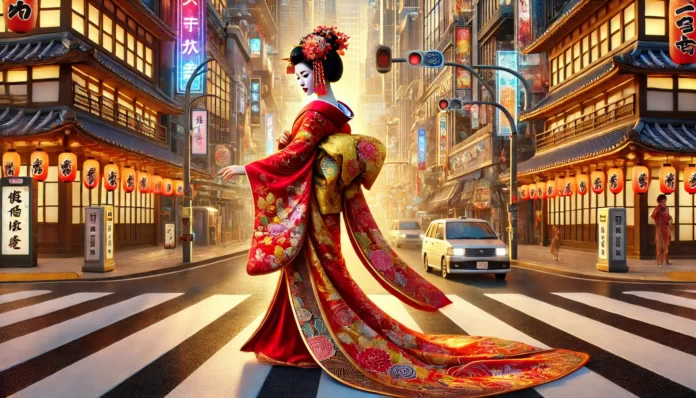The image of a Geisha has long been shrouded in mystery and fascination.
Unfortunately, it is often accompanied by misconceptions, particularly the mistaken association between Geisha and prostitution.
This stereotype has persisted for centuries, fueled by a mix of historical misunderstandings, cultural overlaps, and modern media portrayals.
In reality, Geishas are far from being sex workers; they are cultural icons and skilled performers dedicated to preserving Japan’s rich artistic traditions.
This article delves deeper into the origins of these misconceptions, examines their impact, and highlights the significant role Geishas play in Japanese culture today.
It also addresses the Geisha stigma that has shadowed these artists, emphasizing the need to separate myth from fact.
Geisha and prostitution
Who Are Geishas?
The term Geisha translates to “person of art” in Japanese, reflecting their role as professional entertainers trained in traditional arts.
Emerging during the Edo period (1603–1868), Geishas were originally men but later evolved into a predominantly female profession.
Their purpose was to entertain patrons through music, dance, tea ceremonies, and witty conversation.
Geishas are often recognized by their elaborate kimonos, distinct hairstyles, and iconic white face makeup.
However, their appearance is just the surface of their identity.
Becoming a Geisha requires years of rigorous training in performing arts, language, and etiquette.
Key Characteristics of Geishas:
- Artistic Expertise: Mastery of instruments like the shamisen, traditional dances, and singing.
- Cultural Ambassadors: Representing Japanese traditions at events, teahouses, and private gatherings.
- Refined Social Skills: Engaging guests with charm, intellect, and humor.
Unlike popular misconceptions, Geishas are not courtesans or sex workers.
Their profession revolves around preserving and showcasing Japan’s cultural heritage.
The Origins of the Misconception
The false connection between Geisha and prostitution can be traced back to historical, cultural, and external influences.
Several factors contributed to this misunderstanding:
- Geographic and Cultural Overlaps: During the Edo period, Geishas often worked in close proximity to oiran (high-ranking courtesans) within Japan’s pleasure quarters. While oiran offered sexual services, Geishas were strictly entertainers. The physical closeness of these professions created confusion, particularly for outsiders unfamiliar with Japanese customs.
- Western Misinterpretations: In the late 19th and early 20th centuries, Japan opened its borders to the West. Western visitors, including soldiers and diplomats, often mistook Geishas for courtesans. This misunderstanding was compounded by the fact that Geishas were accessible in social settings where foreign men interacted with Japanese women.
- Media Representation: Books, films, and other forms of media have sensationalized the Geisha profession, often blurring the line between fact and fiction. Works like Memoirs of a Geisha have dramatized elements of Geisha life, perpetuating the false narrative that links them to prostitution. Such portrayals have significantly contributed to the Geisha stigma in modern times.
The Geisha Stigma and Its Impact
The Geisha stigma has cast a shadow over this revered profession, diminishing the respect Geishas deserve as cultural icons. This stigma impacts not only public perception but also the livelihood of modern Geishas.
Key Impacts of the Geisha Stigma:
- Cultural Misunderstanding: Many people outside Japan fail to appreciate the Geisha’s role as artists and entertainers. This reduces their contributions to mere stereotypes, undermining their cultural significance.
- Challenges in Modern Practice: In a rapidly modernizing world, fewer young women choose to pursue the demanding path of becoming a Geisha. The stigma surrounding the profession further discourages potential trainees.
- Erosion of Heritage: The association of Geisha and prostitution distracts from the true purpose of Geishas: to preserve traditional Japanese arts. This misconception jeopardizes the future of these traditions.
Modern-Day Geishas: Preserving Tradition
Despite these challenges, Geishas remain an integral part of Japan’s cultural fabric.
Today, their numbers are smaller, but they continue to thrive in cities like Kyoto, Tokyo, and Kanazawa.
Modern Geishas often perform at exclusive gatherings, cultural festivals, and public events.
Distinguishing Features of Modern Geishas:
- Rigorous Training: Young women (called maiko during their apprenticeship) dedicate years to learning traditional arts and social graces.
- Selective Engagement: Geishas typically entertain clients in exclusive teahouses, maintaining a sense of mystery and prestige.
- Cultural Relevance: They adapt to modern audiences while preserving traditional performances.
The misconception linking Geisha and prostitution has diminished in Japan, thanks to educational efforts and public awareness campaigns.
However, in global contexts, the Geisha stigma persists, requiring continuous clarification and cultural education.
Key Differences: Geisha vs. Prostitution
To dispel the myth, it is crucial to understand the distinct differences between Geishas and sex workers:
| Aspect | Geisha | Prostitution |
|---|---|---|
| Purpose | Artistic entertainment | Sexual services |
| Training | Years of training in arts and etiquette | No formal training in cultural arts |
| Cultural Role | Preservers of Japanese tradition | Commercial and transactional relationships |
| Social Standing | Respected cultural icons | Varied based on context |
Conclusion
The association between Geisha and prostitution is an outdated misconception rooted in historical overlaps and cultural misunderstandings.
Geishas are, and always have been, artists dedicated to preserving Japan’s rich traditions.
By addressing the Geisha stigma, we can better appreciate their contributions as cultural ambassadors.
Understanding this distinction is essential not only for honoring Japanese heritage but also for dismantling stereotypes that obscure the true beauty of Geisha culture.
As modern Geishas continue to uphold centuries-old traditions, it is our responsibility to ensure their legacy is understood and celebrated for what it truly represents: grace, artistry, and cultural preservation.
You might like this: Geisha Stereotypes








